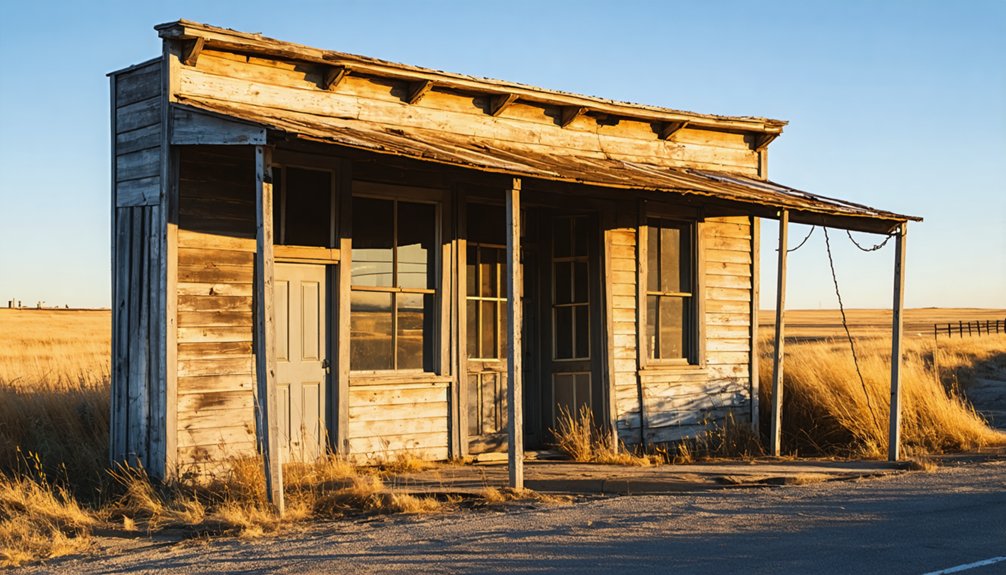You’ll find Slabtown nestled in South Dakota’s Black Hills, where it flourished during the late 19th century mining boom. The settlement supported nearly 100 residents with essential businesses centered around a sawmill and mines, all strategically placed along the railroad’s seven-mile rule. While the town fell silent in 1952 when its primary industry closed, you can still explore the weathered foundations and remnants amid the ponderosa pines, where nature now reclaims this tribute to frontier resilience.
Key Takeaways
- Slabtown emerged during the Black Hills resource boom of the late 19th century, reaching a peak population of nearly 100 residents.
- The town supported mining operations and railroad activities until its decline began in 1952 when primary industries shuttered.
- Located in South Dakota’s Black Hills region, Slabtown features rugged granite peaks, dense pine forests, and diverse wildlife.
- Remnants include weathered building foundations and wooden structures, with original transportation routes now overtaken by native vegetation.
- Visitors should exercise caution due to unstable structures and hidden wells, while respecting private property and historical artifacts.
The Rise and Fall of Slabtown
While many frontier towns emerged during the late 19th century resource booms, Slabtown’s story exemplifies the classic cycle of rise and decline common to Black Hills settlements.
You’ll find its roots in the region’s mining operations and timber extraction, where workers and their families carved out a modest community from the wilderness.
At its peak, Slabtown bustled with nearly 100 residents, supported by a network of essential businesses and transportation links. Like many towns established during the era, its location was determined by the railroad’s seven-mile rule.
The community dynamics centered around the local sawmill and mines, with saloons and general stores serving as gathering spots. Much like Rockerville’s Gaslight Restaurant, a single business operated as the town’s social hub.
But by 1952, when the primary industry shuttered, Slabtown’s fate was sealed.
Repeated flooding, isolation from changing transportation routes, and the exodus of younger generations transformed this once-vibrant settlement into a ghost town, where nature now reclaims the remnants of frontier ambition.
Life in a Mining Settlement
As you explore the daily realities of Slabtown’s mining settlement, you’ll discover a community shaped by the harsh demands of frontier life.
You’d find miners living in simple cabins and tents, gathering at the local saloon after long days of backbreaking work. The hard rock mining operations dominated the landscape by 1880 as surface gold deposits were depleted. The community dynamics revolved around the general store, where you could purchase essential supplies and exchange news with fellow settlers. During the peak mining years, the Holy Terror Mine became one of America’s richest gold producers.
Exhausted miners found solace in Slabtown’s saloon and general store, where daily hardships gave way to community connection.
Economic challenges were constant, as your success depended on mineral prices and the effectiveness of extraction methods.
You’d rely heavily on the newly established railroad to transport equipment and ore, while dealing with the persistent issues of limited water access and basic sanitation.
Despite these hardships, you’d experience the strong bonds that formed among residents, who came together for entertainment, dispute resolution, and mutual support in this rugged mining town.
Natural Surroundings and Geographic Features
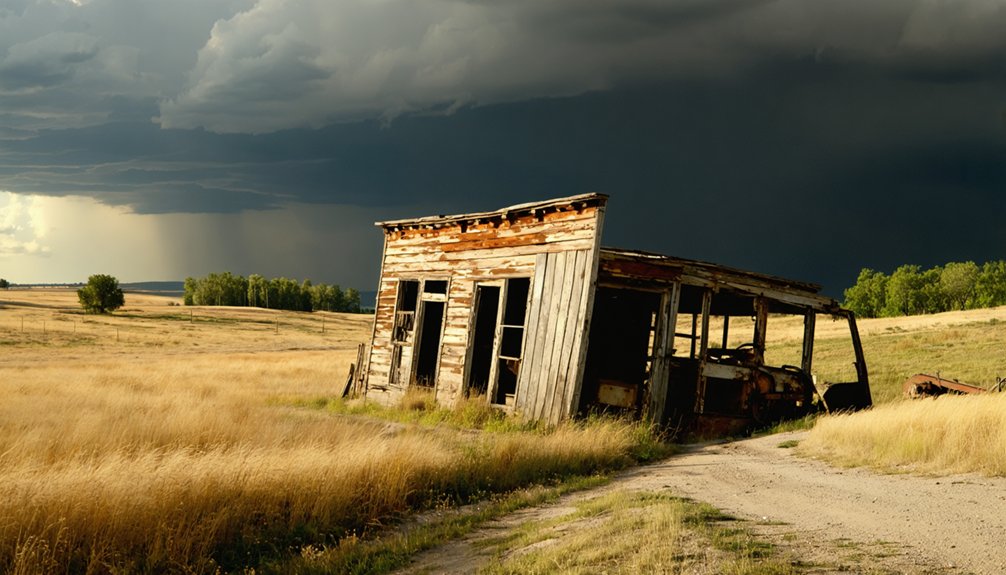
Located within South Dakota’s Black Hills region, you’ll encounter Slabtown’s rugged granite peaks and dense pine forests that typify this distinctive mountain range.
The Black Hills feature Precambrian granite formations that date back over two billion years, making them among the oldest in North America. The surrounding hills support diverse wildlife including white-tailed deer, mountain lions, and various bird species that thrive among the ponderosa pines and native grasses. The area receives up to 30 inches of precipitation annually, creating ideal conditions for the local ecosystem.
You’ll experience dramatic seasonal changes here, from snow-covered winters that once isolated the mining community to hot, dry summers that made early prospecting work particularly challenging.
Black Hills Terrain Characteristics
Rising prominently above the Great Plains grasslands, the Black Hills form a distinctive oval-shaped dome spanning roughly 200 kilometers north-south and 75 kilometers east-west.
You’ll find remarkable terrain diversity throughout the region, from the rugged granite core to the surrounding limestone plateaus and Minnelusa foothills. The geological formations create a complex landscape where elevations climb from 1,030 meters at the base to over 2,190 meters at the highest peaks.
The central core’s steep slopes gradually shift to gentler dips as you move outward. Numerous geological formations, including the gold-bearing Deadwood Formation sandstone and the Pahasapa limestone, have shaped the area’s distinctive features. The dark appearance of the landscape is due to dense coverage of evergreen trees across the hills. These dramatic formations provide towering granite peaks that attract photographers and nature enthusiasts year-round.
This limestone underlies more than 200 caves, while erosion-resistant layers form dramatic hogback ridges and deeply incised valleys.
Local Flora and Fauna
The diverse terrain of the Black Hills creates perfect conditions for a rich tapestry of plant and animal life around Slabtown. Like other ghost town sites across South Dakota, much of the area has reverted to pristine natural spaces.
You’ll find native species thriving in this untamed landscape, from stately ponderosa pines to the resilient Rocky Mountain junipers. Wildlife interactions occur naturally throughout the area’s varied ecosystems, creating a self-sustaining environment that’s remained largely unchanged since the town’s abandonment. The area’s preservation efforts mirror those of the South Dakota Historical Society in maintaining the state’s natural heritage.
- Mule deer and black bears roam freely through the mixed forest, while coyotes patrol their ancient hunting grounds.
- Great horned owls and Steller’s jays claim the towering pines, adding their calls to nature’s chorus.
- Native bumblebees and monarch butterflies maintain essential pollination cycles.
- Lame Johnny Creek sustains a vibrant riparian zone where willows and cottonwoods shelter diverse aquatic life.
Seasonal Weather Patterns
While nestled within South Dakota’s diverse climate zones, Slabtown experiences dramatic seasonal shifts characteristic of both humid continental and semi-arid patterns. You’ll find weather extremes that range from frigid winters with substantial snowfall to warm summers punctuated by thunderstorms.
The nearby Black Hills greatly influence local conditions, creating distinct microclimates that affect temperature and precipitation throughout the year.
During seasonal shifts, you’ll encounter rapid weather changes as continental air masses sweep across the landscape. Spring brings variable temperatures and strong winds, while fall delivers crisp, clear skies.
The Missouri River valley moderates local conditions, though you’ll still face the full force of Great Plains weather patterns. The elevation changes around Slabtown create unique weather variations that you won’t find in surrounding areas.
Exploring the Remnants Today
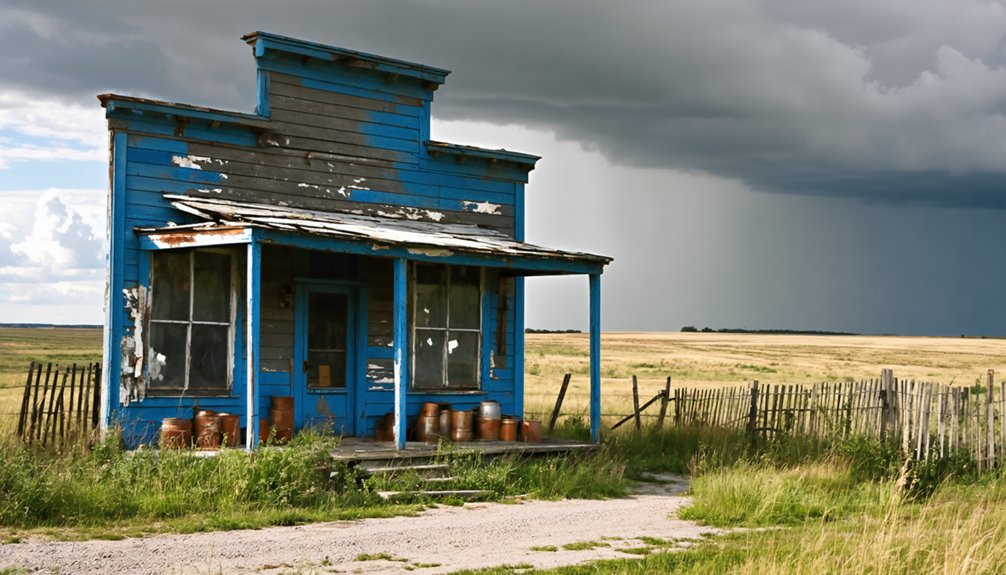
When you visit Slabtown’s remaining structures today, you’ll find mostly deteriorating ruins and foundations scattered across private property, requiring advance permission for access.
You’ll need to exercise caution around unstable buildings and overgrown vegetation while respecting posted “No Trespassing” signs throughout the site.
The absence of visitor facilities or maintained pathways means you should bring appropriate gear for rough terrain and document your exploration route, as the ghost town’s remote location offers no modern amenities or emergency services.
Present-Day Site Conditions
Today, visitors exploring Slabtown’s remnants encounter a landscape where nature steadily reclaims what humans left behind.
You’ll find limited site accessibility, with unpaved roads leading to the town’s location, and no modern visitor amenities on the grounds. The surrounding prairie grass and seasonal elements continue to shape what’s left of the original structures.
- Weathered building foundations peek through overgrown vegetation, marking where homes and businesses once stood.
- Scattered ruins of wooden structures show significant decay from harsh Dakota winters.
- Original transportation routes remain visible but are largely overtaken by native grasses.
- Private property boundaries require visitor awareness and proper permissions for access.
The site’s rustic character and minimal preservation create an authentic glimpse into South Dakota’s abandoned frontier past.
Visitor Safety Guidelines
Exploring Slabtown’s ghost town remnants requires careful attention to safety protocols and proper preparation. When you visit, make sure you’re equipped with essential safety equipment including sturdy boots, gloves, a first aid kit, and plenty of water.
Stay alert to hazard awareness by watching for unstable structures, hidden wells, and wildlife threats like rattlesnakes. You’ll need to stick to visible paths and avoid entering any buildings or mine shafts, as these structures are prone to sudden collapse.
It’s vital that you travel with at least one companion and inform others of your plans, as cell service is unreliable. Bring a fully charged phone and portable power bank, but don’t count on them as your only lifeline.
Remember to respect private property boundaries and leave artifacts undisturbed.
Historical Significance in South Dakota
Nestled in the historic Black Hills region, Slabtown stands as a symbol of South Dakota’s dynamic mining and railroad era of the late 19th to early 20th century.
You’ll discover a compelling story of cultural heritage and economic volatility that shaped this frontier settlement. As you explore the remnants of this once-bustling community, you’ll encounter evidence of the determination that drove South Dakota’s early development.
- Served as a crucial support hub for mining operations and railroad activities, reflecting the region’s industrial expansion
- Exemplified the boom-and-bust cycle common to Black Hills settlements
- Represents the resilient spirit of frontier communities that emerged during South Dakota’s formative years
- Provides valuable insights into the social and economic forces that transformed the territory into a state
Preservation Efforts and Challenges
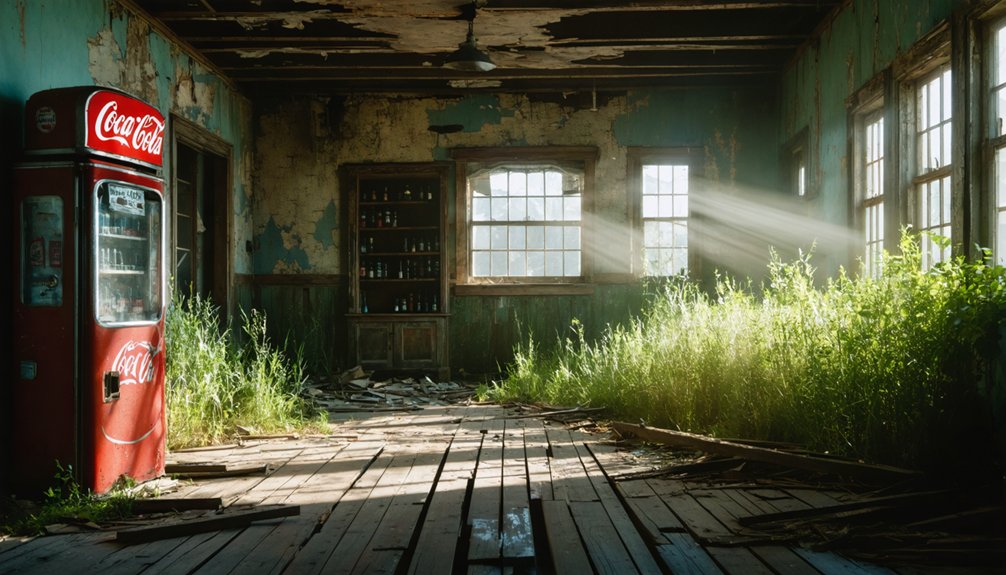
While significant efforts are underway to preserve Slabtown’s historical legacy, the site faces numerous preservation challenges that threaten its survival.
You’ll find limited preservation funding has hampered essential structural stabilization work, leaving many buildings vulnerable to weathering and decay. Natural erosion and overgrowth continue to obscure historic foundations, while vandalism remains an ongoing threat due to insufficient site monitoring.
Despite these obstacles, community engagement through local historical societies and volunteer groups has helped offset some maintenance costs. You can see their impact through interpretive signage and protective fencing, though access remains restricted in certain areas due to private property concerns.
The South Dakota State Historical Society partners with these local organizations to provide expertise and resources, but sustained funding remains vital for Slabtown’s long-term preservation.
Photography and Documentation
Photography stands as a powerful medium for preserving Slabtown’s legacy beyond physical conservation efforts. Through visual storytelling, you’ll discover the town’s rich history captured in the weathered buildings, abandoned rail grades, and everyday artifacts that remain.
Photographers face unique challenges while documenting these historical remnants, including ethical considerations about site preservation and access limitations.
- Early morning and late afternoon shots create dramatic shadows that emphasize the town’s abandoned atmosphere
- Natural elements intertwining with man-made structures tell stories of time’s passage
- Cemetery sites and architectural remains provide compelling focal points for historical documentation
- Written histories paired with images help contextualize Slabtown’s significance in South Dakota’s past
When exploring with your camera, you’ll find countless opportunities to capture the spirit of this once-thriving community while respecting its fragile state.
Planning Your Visit
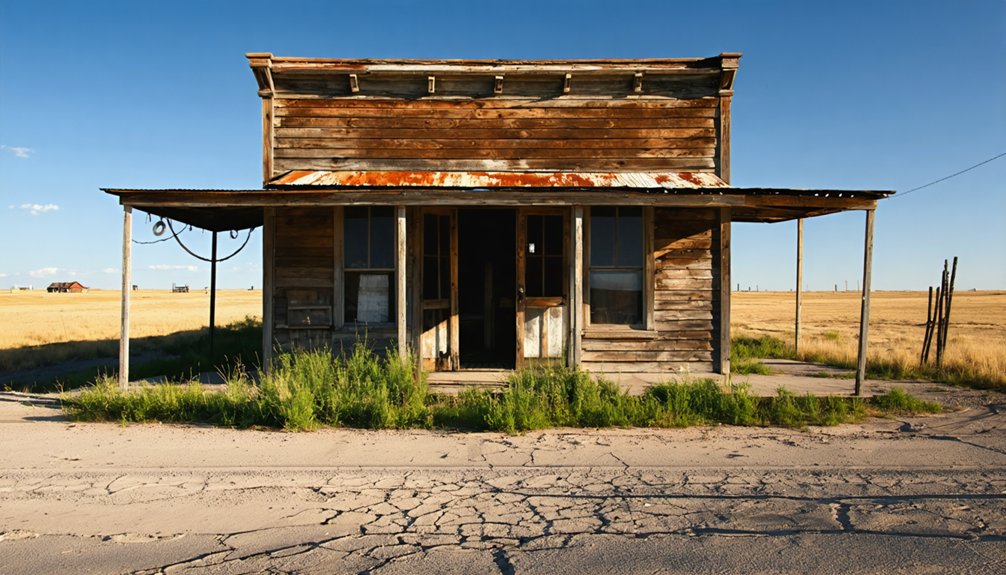
Before starting your journey to Slabtown, you’ll need to carefully plan your expedition to this remote Black Hills ghost town.
Navigate to the site using coordinates 44°24′N 103°52′W, accessible via forest service roads from Spearfish or Deadwood. You’ll require a private vehicle, as no public transportation serves the area.
Check property regulations and obtain necessary permissions before your visit, as the site includes both private and protected lands.
Pack essential supplies including water, food, and emergency gear, as there are no services nearby. Bring sturdy hiking boots and weather-appropriate clothing.
Don’t forget navigation tools like GPS and detailed maps, as cellular coverage is limited. Always inform someone of your travel plans and expected return time.
Remember to stay clear of unstable structures and abandoned mine shafts for your safety.
Frequently Asked Questions
Are There Any Reported Paranormal Activities or Ghost Sightings in Slabtown?
You won’t find documented ghost encounters or supernatural sightings in Slabtown. While other Black Hills ghost towns have established paranormal tales, there’s no verified evidence of ghostly activity in this location.
What Happened to the Original Residents After They Left Slabtown?
Pioneers and prospectors packed their possessions and dispersed. You’ll find original residents migrated to bustling cities like Rapid City, sought railroad work, or moved to farms seeking fresh opportunities.
Were Any Notable Crimes or Mysteries Associated With Slabtown?
You won’t find any documented unsolved murders or historical crimes specifically tied to Slabtown. While nearby mining towns had their share of frontier roughness, no notable mysteries were recorded here.
Did Native American Tribes Have Any Significant Connection to Slabtown’s Location?
You’ll find deep tribal heritage in this location, as it sits within the sacred Black Hills region that holds immense cultural significance to the Lakota Sioux and other Native peoples.
What Valuable Artifacts Have Been Discovered in Slabtown’s Ruins?
Among weathered timbers and dusty soil, you’ll find historical artifacts including square nails, V nickels, buffalo nickels, window glass, mining equipment, and Levi’s buttons unearthed through careful excavation techniques.
References
- https://www.youtube.com/watch?v=Glucs_Rq8Xs
- https://www.powderhouselodge.com/black-hills-attractions/fun-attractions/ghost-towns-of-western-south-dakota/
- https://www.sdhspress.com/journal/south-dakota-history-2-2/some-black-hills-ghost-towns-and-their-origins/vol-02-no-2-some-black-hills-ghost-towns-and-their-origins.pdf
- https://www.sdpb.org/rural-life-and-history/2023-08-21/some-black-hills-ghost-towns-and-their-origins
- https://www.youtube.com/watch?v=_0WNYsFLSLA
- https://www.blackhillsbadlands.com/blog/post/old-west-legends-mines-ghost-towns-route-reimagined/
- https://en.wikipedia.org/wiki/List_of_ghost_towns_in_South_Dakota
- https://icatchshadows.com/okaton-and-cottonwood-a-photographic-visit-to-two-south-dakota-ghost-towns/
- https://openprairie.sdstate.edu/etd/4061/
- https://aberdeenmag.com/2019/01/the-ghost-towns-of-brown-county/
